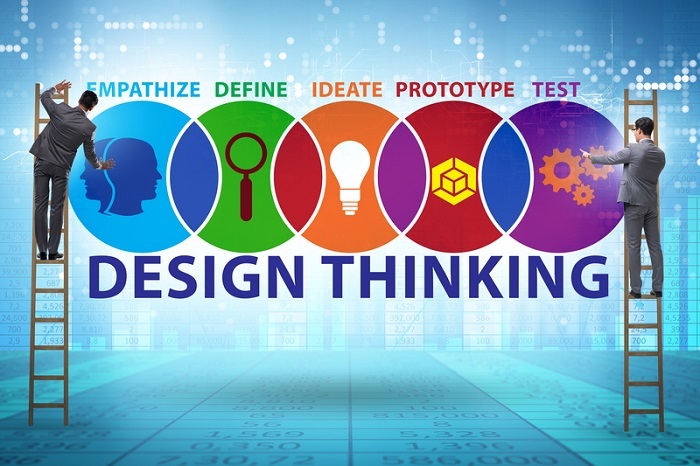
 Data Structure
Data Structure Networking
Networking RDBMS
RDBMS Operating System
Operating System Java
Java MS Excel
MS Excel iOS
iOS HTML
HTML CSS
CSS Android
Android Python
Python C Programming
C Programming C++
C++ C#
C# MongoDB
MongoDB MySQL
MySQL Javascript
Javascript PHP
PHP
- Selected Reading
- UPSC IAS Exams Notes
- Developer's Best Practices
- Questions and Answers
- Effective Resume Writing
- HR Interview Questions
- Computer Glossary
- Who is Who
The Concept of Design Thinking and the Benefits of Design Thinking
Design thinking is a modern, humane, and creative way to solve business problems. In the business world today, where automation and data are the key factors, design thinking helps in solving problems and running the business in a more human way. Companies that automate are losing their human touch; for them, generalization and mass production of goods and services are the key factors in satisfying consumers and their needs. But while doing this, they are losing the humanity and creativity of business. A product that is the same for all and is low-priced can be replaced by another low-priced and generalized product. What will keep your consumers loyal are products that satisfy their needs and companies that hear and value their feedback and suggestions.

In this article, we will be diving deep into the basic concept of design thinking and the benefits of applying the design thinking process in your business will be.
The Five Phases of Design Thinking
Design thinking is the creative and human way to solve business problems. Individuals are challenging and questioning the problem, the stated implications of the solutions, and the company's assumptions. The five phases of design thinking are not followed in chronological order. Consumers can move in between the steps and skip steps as and when required. The five steps are ?

Empathize with consumers ? Here, the business is empathizing with the consumer and their problems. By consumers, we mean the end users of the product and not the clients in between them. The marketers observe the consumer, conduct research, and take suggestions and feedback to get to the core of the problem. In this process, the marketers basically get into the shoes of the consumer.
Define the problem ? After collecting the data on consumer behavior patterns, it is time for companies to define the problem statement. There could be a slew of issues that arise during the data collection stage, but the company should begin with the most pressing problem statement.
Ideate the solutions ? This is the stage where the stakeholders and different functional departments meet together to find different solutions for the problem. This is the zone where, instead of taking comments personally, employees express their views from each angle. For example, the finance department will comment on the budgeting aspect and the design team on the look and design of the solution.

Prototype the solutions ? After shortlisting some of the solutions mentioned above, it is time to buckle up and actually give a form to the solution statement. A lot of the solutions fail in this stage as it becomes difficult to prototype because of a lack of budget, technology, or resources, but some sail through.
Testing the prototype ? Once the solutions have been developed, it is time to put the product and service to the test. Companies can decide upon the focus group and record their reaction while consuming and looking at the product. The one that sails through this stage is the one that is finally launched on the market. If the product does not perform well, then the marketer has to go through the step of ideating again.
Benefits of Design Thinking
After understanding the design thinking process, it is time to understand why a company would want to incur such high costs and invest so much time in developing solutions.
It aids in viewing the problem from a different angle ? Design thinking aids in viewing issues or problems from a different angle. With design thinking, you are not caught up in product myopia. You can have a better understanding of what is disturbing the consumer and how it can be resolved. It gives you a more subjective view of the problem. For example, Indian consumers (mainly the rural segment) have the habit of recognizing the color green with dishwashing bars and blue for washing clothes. When companies mismatched the color, consumers got confused. In Pakistan as a country, the opposite occurs.
Root cause analysis ? since design thinking questions the problem statement, the assumptions of the company, and the implications, it helps businesses understand the root cause of the problem. Now, with the depth of information available, companies can better their products and services in literal terms other than just doing a cosmetic treatment.
Encourages creative thinking ? Design thinking assists businesses in breaking free from the monotony of solutions. If the sales are low, introducing the "buy one, get one free" model is not always the solution. Companies have to understand that consumers want creative solutions to their modern-day complicated problems. By empathizing with the consumer and ideating with all the functional departments, design thinking ensures that they have creative solutions to their modern problems.
Gives the company an edge over its competitors ? The company that uses design thinking as its problem-solving approach will always have an edge over its competitors. The competitor will be using the basic market methods, but here the company is providing them with creative solutions. Generally, it is found that consumers are willing to pay extra for goods they find unique and that will ease their process.
Gives you access to a database ? While empathizing with the consumers, a company will find myriad points of consideration, and these points can become points of innovation in the near future. Companies now have a database on how to improve their customer experience.
Human-centered approach ? consumers want companies to not view them as objects or dumping grounds for their goods, and with Design Thinking, companies can promote their humanness.

Design thinking is the new buzzword in the problem-solving market. It is time-consuming and very subjective, but these weaknesses are the strengths of design thinking. With design thinking, companies can choose a radical approach to putting the humanness of their company front and center. With design thinking, companies can challenge the data-related outcomes of their businesses. Companies have to understand that data provides insight into consumers and their habits. At the end of the day, consumers are emotional beings, and they react in unpredictable ways. Marketing would not have been called an art if one approach was sufficient to convince or persuade them. Design thinking is the middle ground, as it collects data while empathizing with the consumer and also uses it creatively to develop solutions and better understand the data.

